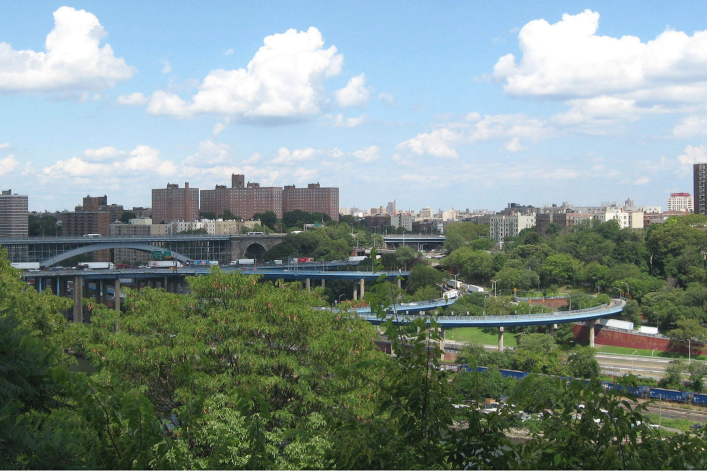Robert Caro on the enduring legacy of Robert Moses

The city planner Robert Moses looms large over New York’s landscape, and the decisions he made continue to influence the flow and pace of life here. And Robert Caro’s biography, The Power Broker: Robert Moses and the Fall of New York, which was published over 40 years ago, remains the definitive examination of a man who dominated NYC development for decades.
The New York Public Library’s current display at the Stephen A. Schwarzman Building touches upon some of Caro’s sources for the book, which he found within the Library’s collections during his tenure as a resident researcher. The display is the first in a new "Made at NYPL" series, which recognizes works whose authors tapped into NYPL research collections.
William Kelly, the Library’s Andrew W. Mellon Director of the Research Libraries, says the exhibit "highlights some of the most consequential examples of that work," starting with The Power Broker, Caro's biography of Moses, which he says, "launched Caro's seminal, and ongoing, investigation of the workings of power in twentieth-century America."
Though a small exhibit, it illuminates the depths of Caro’s investigation, as well as Moses’ staggering impact: On one placard, Caro reflects on interviewing Moses in his home, where he saw him framed by the causeway and park that bear his name.
Caro spoke with Gothamist recently about his work on the book, as well as the shadow Moses continues to cast over the city today. What’s remarkable about Moses, Caro told the website, is that he amassed so much power without ever being elected to political office. Instead, his influence came from the control he attained in his career over several public authorities—including the Port Authority and the Long Island State Park Commission—which allowed him to do “something no one else had ever done,” Caro said.
And much of what he did, according to Caro, was exacerbate social stratification. The conversation addresses how Moses’ work resulted in enormous swaths of the city—and its surrounding suburbs—remaining dependent on car travel. The interviewer mentions that in 1955, the Triborough Authority and the Port Authority—of which Moses was Chairman and Director, respectively—had the resources at the time to dramatically expand the LIRR and construct tunnels for the Second Avenue Subway. (Meanwhile, 60 years later, we’re still waiting for construction on the Second Avenue subway to end.) Instead, Moses used the funds to build highways, including the Long Island Expressway.
Caro adds: “Whenever you drive out on Long Island, you just sit in these traffic jams on the LIE or wherever, you really say, 'It didn’t have to be like this.' It would have been so easy to fix it.” At the time of the roadway’s construction, he says, Moses’ colleagues observed that areas of Long Island, which were then farmland, would experience increased development as a result, and that “the thing to do was built a light rail line, down the center. There’ll be little apartment houses near each exit, and the people who want to go into New York by train will have that option.” It’s a vision of a more urbanized, and less isolated, Long Island.
By not heeding this advice, Untapped Cities notes, in addition to the congestion, Moses’ LIE contributed to socioeconomic segregation in the region, by making it impossible for poorer, non-drivers to reach the suburbs—and the parks and facilities Moses built there.
Moses’ racism is another major topic: Caro contends that Moses was “the most racist human being I had ever really encountered.” In The Power Broker, he describes how another of Moses’ thoroughfares, the Cross Bronx Expressway, cut the Bronx in half, a move that again favored those who could afford cars, while displacing many of the low-income residents and people of color who lived in the region. The neighborhood of East Tremont, he writes, was particularly hard hit, a formerly family-oriented area that became notorious for its blight in the wake of the expressway’s construction.
The legacy of segregation in the suburbs, too, can be attributed in part to Moses’ personal biases, Caro says. The city planner didn’t want poor people of color from the city accessing Jones Beach, which was established while Moses was President of the Long Island State Park Commission, so he made it illegal for buses to travel on the parkways there. Furthermore, Caro says, “Then he had this quote, and I can still hear him saying it to me. ‘Legislation can always be changed. It’s very hard to tear down a bridge once it’s up.’ So he built 180 or 170 bridges too low for buses… this is how you can shape a metropolis for generations.”
Considering that an analysis of 2010 Census data found that the New York area is the second most segregated in the county—and that city schools are struggling to address the same issue—it seems that the development decisions of decades past continue to affect NYC's demographics.
Related:
How NYC buildings create community (and turn into a small village)






















